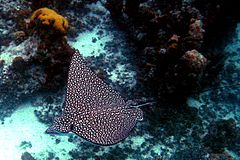Eagle ray facts for kids
Quick facts for kids Eagle rayTemporal range:
Upper Cretaceous to Recent |
|
|---|---|
 |
|
| Spotted Eagle Ray, Aetobatus narinari | |
| Scientific classification | |
| Kingdom: | |
| Phylum: | |
| Class: | |
| Subclass: | |
| Superorder: | |
| Order: | |
| Suborder: | |
| Family: |
Myliobatidae
Bonaparte, 1838
|
Eagle rays are amazing fish with skeletons made of cartilage, not bone. They belong to the ray family called Myliobatidae. These large fish usually live in the wide open ocean, not on the seafloor like some other rays.
Eagle rays mostly eat molluscs like clams and crabs. They have special flat teeth that help them crush the shells of their prey. Other rays, like devil rays and manta rays, eat tiny plankton by filtering water.
These rays are excellent swimmers. They can even jump several meters out of the water! Compared to other rays, eagle rays have long tails. Their bodies are shaped like a diamond, which helps them glide through the water.
What Makes Them Special?
Eagle rays have a unique look. Their tails are long and thin, like a whip. These tails can be as long as their bodies. Some eagle rays have a sting on their tail, which they use for defense.
You can often spot eagle rays swimming close to the coast. They usually live in waters from 1 to 30 meters deep. Sometimes, they can be found much deeper, up to 300 meters! They love to cruise along sandy beaches in very shallow water.
Life Cycle and Reproduction
Eagle rays are ovoviviparous. This means their babies grow inside eggs that stay inside the mother's body. The eggs hatch inside her, and then she gives birth to live young. A mother eagle ray can give birth to up to six babies at one time.
These rays come in different sizes. They can be as small as 48 centimeters (about 19 inches) long. The largest ones can grow up to 9.1 meters (about 30 feet) long!
Where Do Eagle Rays Fit In?
Eagle rays are part of a larger group of fish. They belong to the suborder Myliobatoidei. This group also includes manta rays and devil rays. Scientists group animals together based on their shared features. This helps us understand how different species are related.
See also
 In Spanish: Raya águila para niños
In Spanish: Raya águila para niños

